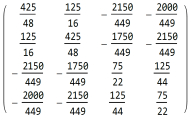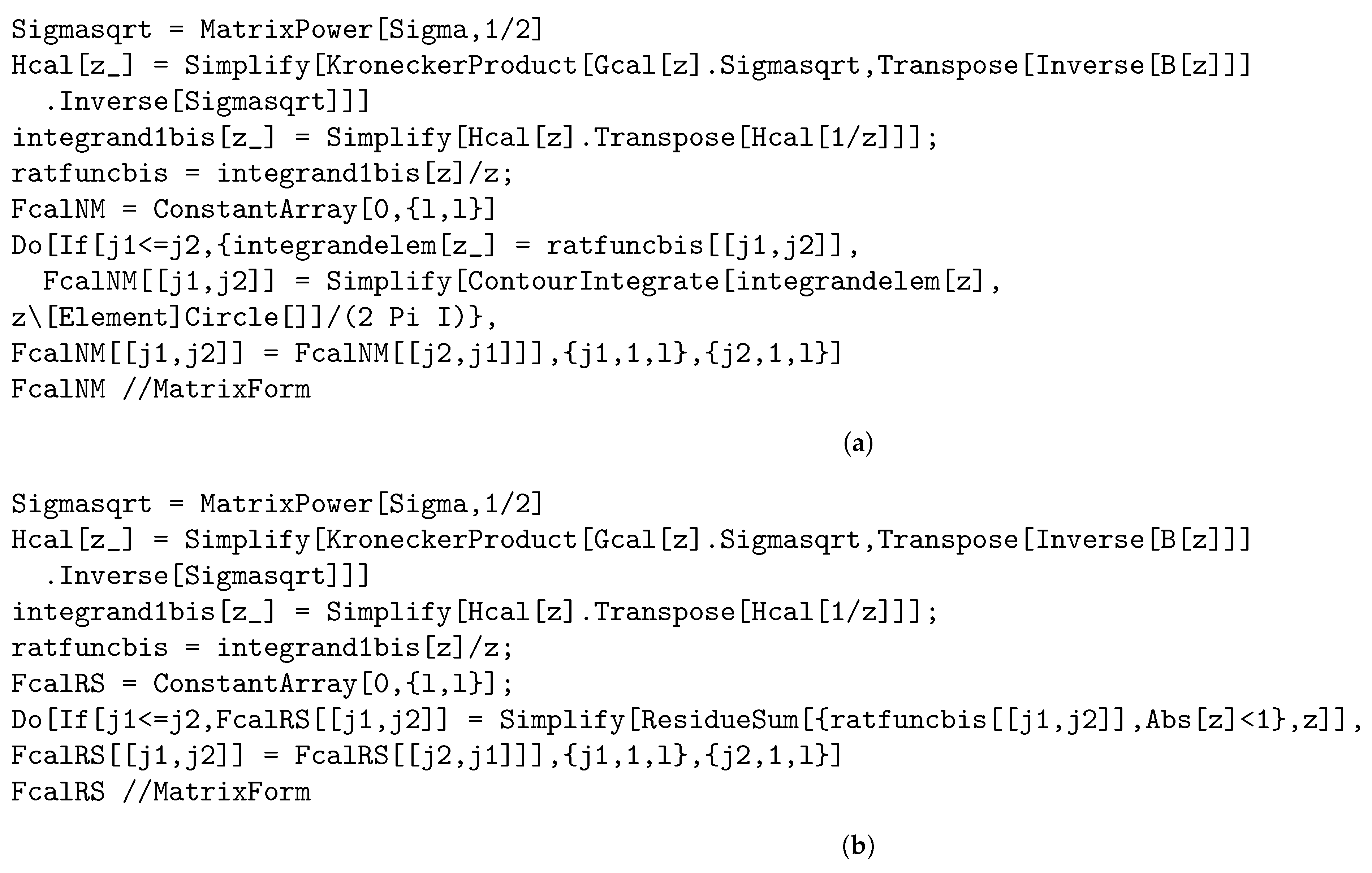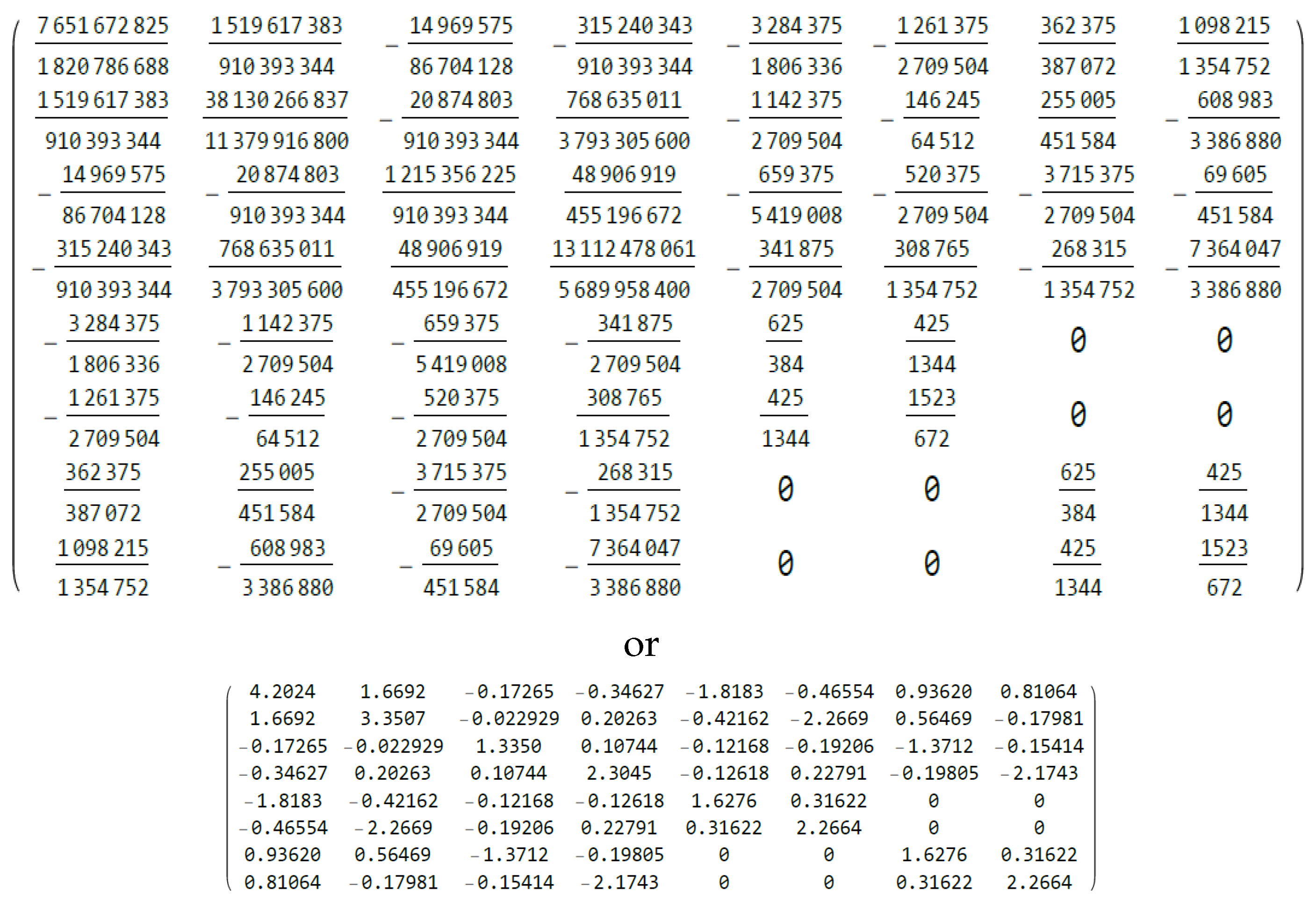A Symbolic Algorithm for Checking the Identifiability of a Time-Series Model
Abstract
1. Introduction
2. Materials and Methods
The open-source packages Octave and Maxima should be able to do the job since their symbolic integration procedure can work on matrices of functions, but they do not work presently. More developments would be needed to circumvent their failing integration.
- I tried with more recent versions without much success. Therefore, I had no other choice than to search for alternative approaches.
3. Results
3.1. An Alternative Integral Representation
3.2. Methods Using Cauchy’s Residues
3.3. An Algorithm for Integrating Rational Functions Around the Unit Circle
- has all its zeros strictly inside the unit circle; and
- has all its zeros strictly outside the unit circle;
3.4. A New Algorithm for Mathematica
 or
or 
3.5. An Algorithm for Maxima
3.6. An Algorithm for Octave
3.7. Application on Examples 3 and 4
4. Discussion
- The method proposed in [26];
- The variant proposed in Section 3.3;
- The method based on the experimental ResidueSum.
- We have seen in Section 3.3 that the three methods give the same exact results.
- The symbolic method using circintrat.m based on Söderström’s algorithm that gives the same exact results as Mathematica;
- The numerical method based on a function residuesum.m that gives approximately the same numerical results, at least in the examples.
- There is no doubt that the latter method with the function residuesum.m in Octave can lead to problems in near-singular cases.
5. Conclusions
Supplementary Materials
Funding
Institutional Review Board Statement
Informed Consent Statement
Data Availability Statement
Acknowledgments
Conflicts of Interest
Abbreviations
| AFIM | Asymptotic Fisher information matrix |
| AR | Autoregressive |
| ARMA | Autoregressive moving average |
| ARMAX | Autoregressive moving average with explanatory variables |
| MA | Moving average |
| SISO | Single-input single-output |
| VARMA | Vector autoregressive moving average |
| VARMAX | Vector autoregressive moving average with explanatory variables |
References
- Hannan, E.J. The identification of vector mixed autoregressive-moving average systems. Biometrika 1969, 56, 223–225. [Google Scholar]
- Hannan, E.J. The identification problem for multiple equation systems with moving average errors. Econometrica 1971, 39, 751–765. [Google Scholar] [CrossRef]
- Hannan, E.J.; Deistler, M. The Statistical Theory of Linear Systems; Wiley: New York, NY, USA, 1988. [Google Scholar]
- Whittle, P. Estimation and information in time series. Ark. Mat. 1953, 2, 423–434. [Google Scholar] [CrossRef]
- Box, G.E.P.; Jenkins, G.M.; Reinsel, G.C.; Ljung, G.M. Time Series Analysis Forecasting and Control, 5th ed.; Wiley: Hoboken, NJ, USA, 2015. [Google Scholar]
- Godolphin, E.J.; Unwin, J.M. Evaluation of the covariance matrix for the maximum likelihood estimator of a Gaussian autoregressive-moving average process. Biometrika 1983, 70, 279–284. [Google Scholar] [CrossRef]
- Porat, B.; Friedlander, B. Computation of the exact information matrix of Gaussian time series with stationary random components. IEEE T. Acoust. Speech 1986, 14, 118–130. [Google Scholar] [CrossRef]
- Klein, A.; Mélard, G. On algorithms for computing the covariance matrix of estimates in autoregressive-moving average models. Comput. Stat. Q. 1989, 5, 1–9. [Google Scholar]
- Klein, A.; Mélard, G. Fisher’s information matrix for seasonal autoregressive-moving average models. J. Time Ser. Anal. 1990, 11, 231–237. [Google Scholar] [CrossRef]
- Godolphin, E.J.; Bane, S.R. On the evaluation of the information matrix for multiplicative seasonal time-series models. J. Time Ser. Anal. 2005, 27, 167–190. [Google Scholar] [CrossRef]
- Godolphin, E.J.; Godolphin, J.D. A note on the information matrix for multiplicative seasonal autoregressive moving average models. J. Time Ser. Anal. 2007, 28, 167–190. [Google Scholar] [CrossRef]
- Gevers, M.; Ljung, L. Optimal experiment designs with respect to the intended model application. Automatica 1986, 22, 543–544. [Google Scholar] [CrossRef]
- Klein, A.; Spreij, P. On Fisher’s information matrix of an ARMAX process and Sylvester’s resultant matrices. Linear Algebra Appl. 1996, 237/238, 579–590. [Google Scholar] [CrossRef]
- Ljung, L.; Söderström, T. Theory and Practice of Recursive Identification; MIT Press: Cambridge, MA, USA, 1983. [Google Scholar]
- Young, P.C. Recursive Estimation and Time-Series Analysis: An Introduction for the Student and the Practitioner, 4th ed.; Springer: Heidelberg, Germany, 2011. [Google Scholar]
- Klein, A.; Mélard, G. An algorithm for computing the asymptotic Fisher information matrix for seasonal SISO models. J. Time Ser. Anal. 2004, 25, 627–648. [Google Scholar] [CrossRef]
- Newton, H.J. The information matrices of the parameters of multiple mixed time series. J. Multivar. Anal. 1978, 8, 317–323. [Google Scholar] [CrossRef]
- Klein, A.; Mélard, G.; Spreij, P. On the resultant property of the Fisher information matrix of a vector ARMA process. Linear Algebra Appl. 2005, 403, 291–313. [Google Scholar] [CrossRef]
- Athanasopoulos, G.; Vahid, F. VARMA versus VAR for macroeconomic forecasting. J. Bus. Econ. Stat. 2008, 26, 237–252. [Google Scholar] [CrossRef]
- Bao, Y.; Hua, Y. On the Fisher information matrix of a vector ARMA process. Econ. Lett. 2014, 123, 14–16. [Google Scholar] [CrossRef]
- Zadrozny, P.A. Analytical derivatives for estimation of linear dynamic models. Comput. Math. Appl. 1989, 18, 539–553. [Google Scholar] [CrossRef]
- Lomba, J.T. Estimation of Dynamic Econometric Models with Errors in Variables; Springer: Berlin, Germany, 1990. [Google Scholar]
- Zadrozny, P.A. Errata to ’Analytical derivatives for estimation of linear dynamic models’. Comput. Math. Appl. 1992, 24, 289–290. [Google Scholar] [CrossRef]
- Mittnik, S.; Zadrozny, P.A. Asymptotic distributions of impulse responses, step responses, and variance decompositions of estimated linear dynamic model. Econom. 1993, 61, 857–870. [Google Scholar] [CrossRef]
- Jerez, M.; Casals, J.; Sotoca, S. Signal Extraction for Linear State-Space Models; Lambert Academic Publishing: Saarbrücken, Germany, 2011. [Google Scholar]
- Klein, A.; Mélard, G. An algorithm for the Fisher information matrix of a VARMAX process. Algorithms 2023, 16, 364. [Google Scholar] [CrossRef]
- Klein, A.; Spreij, P. Tensor Sylvester matrices and the Fisher information matrix of VARMAX processes. Linear Algebra Appl. 2010, 432, 1975–1989. [Google Scholar] [CrossRef]
- Dym, H. Linear Algebra in Action, 2nd ed.; American Mathematical Society: Providence, RI, USA, 2013. [Google Scholar]
- Söderström, T. Description of a Program for Integrating Rational Functions Around the Unit Circle; Technical Report 8467R; Department of Technology, Uppsala University: Uppsala, Sweden, 1984; Unpublished work. [Google Scholar]
- Düker, M.-C.; Matteson, D.S.; Tsay, R.S.; Wilms, I. Vector autoregressive moving average models: A review. arXiv 2024, arXiv:2406.19702. [Google Scholar]
- Gourieroux, C.; Monfort, A.; Trognon, A. Pseudo maximum likelihood methods: Theory. Econometrica 1984, 52, 681–700. [Google Scholar] [CrossRef]
- Klein, A.; Spreij, P. Matrix differential calculus applied to multiple stationary time series and an extended Whittle formula for information matrices. Linear Algebra Appl. 2010, 430, 674–691. [Google Scholar] [CrossRef]
- Mélard, G. An indirect proof for the asymptotic properties of VARMA model estimators. Econom. Stat. 2022, 21, 96–111. [Google Scholar] [CrossRef]
- Peterka, V.; Vidinčev, P. Rational-fraction approximation of transfer functions. In Proceedings of the IFAC Symposium on Identification in Automatic Control Systems, Prague, Czechoslovakia, 12–17 June 1967. [Google Scholar]
- Davis, R.A.; Dunsmuir, W.T.M.; Streett, S.B. Maximum likelihood estimation for an observation driven model for Poisson counts. Methodol. Comput. Appl. 2005, 7, 149–159. [Google Scholar] [CrossRef]
- Fokianos, K.; Rahbek, A.; Tjøstheim, D. Poisson autoregression. J. Am. Stat. Assoc. 2009, 104, 1430–1439. [Google Scholar] [CrossRef]
- Fokianos, K. Count time series models. In Time Series: Methods and Applications, Handbook of Time Series Analysis; Subba Rao, T., Subba Rao, S., Rao, C.R., Eds.; Elsevier: Amsterdam, The Netherlands, 2012; Volume 30, pp. 315–347. [Google Scholar]
- Liboschik, T.; Fokianos, K.; Fried, R. tscount: An R package for analysis of count time series following generalized linear models. J. Stat. Softw. 2017, 82, 5. [Google Scholar] [CrossRef]
- Fokianos, K.; Støve, B.; Tjøstheim, D.; Doukhan, P. Multivariate count autoregression. Bernoulli 2020, 26, 471–499. [Google Scholar] [CrossRef]
- Benjamin, M.A.; Rigby, R.A.; Stasinopoulos, M.D. Fitting non-Gaussian time series models. In COMPSTAT 1998: Proceedings in Computational Statistics; Payne, R., Green, P., Eds.; Physica Verlag: Heidelberg, Germany, 1998; pp. 191–196. [Google Scholar]
- Kugiumtzis, D.; Bora-Senta, E. Gaussian analysis of non-Gaussian time series. Bruss. Econ. Rev. 2010, 53, 295–322. [Google Scholar]
- Drost, F.C.; Klaassen, C.A.J.; Werker, B.J.M. Adaptive estimation in time-series models. Ann. Stat. 1997, 25, 786–818. [Google Scholar] [CrossRef]
- Hallin, M.; Werker, B.J.M. Optimal testing for semiparametric AR models: From Lagrange multipliers to autoregression rank scores and adaptive tests. In Asymptotics, Nonparametrics and Time Series; Ghosh, S., Ed.; Marcel Dekker: New York, NY, USA, 1999; pp. 295–350. [Google Scholar]
- Hallin, M.; Paindaveine, D. Rank-based optimal tests of the adequacy of an elliptic VARMA model. Ann. Stat. 2004, 32, 2642–2678. [Google Scholar] [CrossRef]
- Hallin, M.; La Vecchia, D. R-estimation in semiparametric dynamic location-scale models. J. Econom. 2017, 196, 233–247. [Google Scholar] [CrossRef]
- Hallin, M.; La Vecchia, D.; Liu, H. Center-outward R-estimation for semiparametric VARMA models. J. Am. Stat. Assoc. 2020, 117, 925–938. [Google Scholar] [CrossRef]



| Software | Integral | New Integral | ResidueSum | Residue | Söderström |
|---|---|---|---|---|---|
| Mathematica | not used | NA | |||
| Maxima | wrong (0) | NA | NA | ||
| Octave | wrong (0) | NA | * |
| Software | Integral | New Integral | ResidueSum | Residue | Söderström |
|---|---|---|---|---|---|
| Mathematica | not used | NA | |||
| Maxima | wrong ($) | NA | NA | ||
| Octave | wrong (0) | NA | * |
Disclaimer/Publisher’s Note: The statements, opinions and data contained in all publications are solely those of the individual author(s) and contributor(s) and not of MDPI and/or the editor(s). MDPI and/or the editor(s) disclaim responsibility for any injury to people or property resulting from any ideas, methods, instructions or products referred to in the content. |
© 2024 by the author. Licensee MDPI, Basel, Switzerland. This article is an open access article distributed under the terms and conditions of the Creative Commons Attribution (CC BY) license (https://creativecommons.org/licenses/by/4.0/).
Share and Cite
Mélard , G. A Symbolic Algorithm for Checking the Identifiability of a Time-Series Model. Information 2025, 16, 16. https://doi.org/10.3390/info16010016
Mélard G. A Symbolic Algorithm for Checking the Identifiability of a Time-Series Model. Information. 2025; 16(1):16. https://doi.org/10.3390/info16010016
Chicago/Turabian StyleMélard , Guy. 2025. "A Symbolic Algorithm for Checking the Identifiability of a Time-Series Model" Information 16, no. 1: 16. https://doi.org/10.3390/info16010016
APA StyleMélard , G. (2025). A Symbolic Algorithm for Checking the Identifiability of a Time-Series Model. Information, 16(1), 16. https://doi.org/10.3390/info16010016







